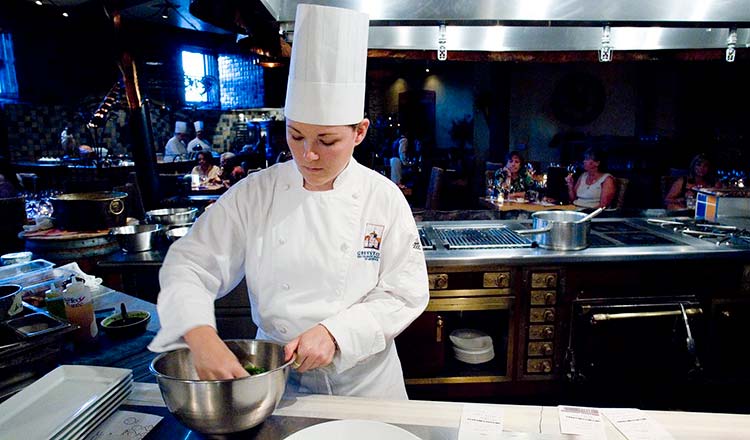At the CIA, we teach future chefs the best way to slice, dice, and sauté. Just like all old (ancient!) art-forms, there are foundational techniques that everyone must learn before they can become experts.
But even seasoned chefs take shortcuts, especially at home. After all, we all have different needs, different tools, and even different bodies. Knowing the “right” way might help you increase your speed and efficiency in a professional kitchen, but sometimes the right way isn’t right for you, so don’t be afraid to try things your own way in your own kitchen.
You may have read about “kitchen hacks,” which are fun or convenient shortcuts to help you eat a pineapple or chop an onion. Some of these hacks, or tricks, are gimmicky and can even make more work of a simple task, but there are a few things I do that make kitchen-life easier. They aren’t so much tricks as just chef-permission to work smart, not hard. For example, I know they are often multi-step recipes with streaming and whisking, but it really is okay to put all of your vinaigrette ingredients into a jar and shake it.
Easy Peasy Lemon Squeezy
Between flavoring my water or brightening a soup, we use a lot of lemons. If you need a lot of freshly squeezed lemon juice, you might use a citrus reamer or juice press, but most of the time, you’ll just need a wedge or two. Seeds are a nuisance, and one easy way to avoid them is to cut your lemon wedges around the seedy core. Instead of slicing through the center to make two halves and then quarters, slice through the lemon about 1/4-inch to the right of the core. Keep rotating the lemon until you’ve cut four “cheeks” off of the fruit. These little cheeks can be squeezed seed-free! I usually toss the seedy centers into my water or iced tea pitcher.
Cool Runnings
Dinner can be a pickle when you realize your ingredients are still frozen! Remember that everything defrosts faster (and safely) under cool running water. Shrimp and small items will defrost in literal minutes, but in thirty minutes or so, you can defrost portioned items chicken breasts or pork chops. Otherwise, remember that you can cook meats and other items in your electric pressure cooker from frozen!
Go Nuts
Have you ever seen a recipe that called for toasted and peeled hazelnuts? Peeling tiny little nuts sort of seems like a joke, but there’s an easy way! As soon as you pull those nuts from the oven, drop them in a colander (the one you use for pasta is fine). Roll them around, using your hand to exert some light pressure as they roll, if you need to, and those skins will fall right through the holes. This works for peanuts and any nuts with that familiar papery skin (so, basically all of them).
Shake It Up
Egg salad is a nostalgic treat, but is there a job more frustrating than peeling hardboiled eggs? Next time, put your cooked and cooled eggs (drop them in an ice bath as soon as they’re done!) in a lidded container. Shake shake shake until the shells are basically disintegrated, just a minute or so. Then you can easily peel off what’s left under running water. This trick is also handy for peeling lots of garlic cloves at once!
Make a Splash
If you run out of white wine to deglaze your pan, look to the liquor cabinet. Dry vermouth is a great sub, but you can also use sherry or brandy in a pinch, though the flavor won’t be quite the same. If that’s not helpful, lemon juice, chicken broth, olive brine, vinegar, or even water will get the job done.
Green Goddess
How about brown avocados? No one likes ‘em, but they aren’t a foregone conclusion. If you want to make guacamole the day before a party, mix it up and put it in your serving bowl. Smooth the top of it as well as you can, then add enough cool water to cover the surface of the guacamole by about 1/2-inch or so. Refrigerate it, and then when you’re ready to serve it, dump off the water, give the whole thing a quick stir, and relish in your made-ahead green guacamole. You can use this trick to store half an avocado, too. Put the avocado face-down in a container and put in enough water to cover the avocado by about half. It will only stay nice for a day or two, but that’s 10 years in the life of an avocado.
Not Slippery When Wet
Cutting boards are a cook’s best friend, but a slippery board is our worst enemy. For a quick fix to a cutting board that slides around the countertop, dampen a paper towel and spread it under your board. That will produce enough friction to keep your board in place. For a chronically slippy board (or delicate countertops), look for small stick-on silicone feet at a home store to stick on the four corners. It will turn a double-sided board into a single-side one, but you can peel the feet off and flip the board over every few months for even wear.
Better Butter
Love to bake? Don’t forget to soften that butter! But if you do, cut your butter into small cubes and let it rest at room temperature as long as you can. About ten minutes should do the trick, and once you transfer it to your mixer, an extra minute or so of paddling will help make up any difference in temperature. If you need a little extra help, place a hot water bath or a hot towel under the bowl of the mixer while it goes.


